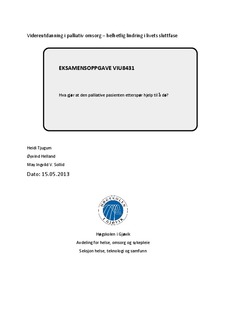| dc.contributor.author | Tjugum, Heidi | |
| dc.contributor.author | Helland, Øyvind | |
| dc.contributor.author | Sollid, May Ingvild | |
| dc.date.accessioned | 2013-07-02T09:13:05Z | |
| dc.date.available | 2013-07-02T09:13:05Z | |
| dc.date.issued | 2013 | |
| dc.identifier.uri | http://hdl.handle.net/11250/144578 | |
| dc.description.abstract | NORSK: Dette litteraturstudiet diskuterer forhold som gjør at den palliative pasienten etterspør hjelp til å dø. Med utgangspunkt i teori om palliativ omsorg, hospicefilosofi, livskvalitet og etikk blir problemstillingen drøftet i lys av inkluderte forskningsartikler og annen faglitteratur, samt egen klinisk erfaring fra arbeid som sykepleiere og fysioterapeut.
Den palliative pasientens ønske om hjelp til å dø kan ha bakgrunn i fysiske plager, men også psykiske og eksistensielle plager. Det kommer frem at den palliative pasientens ønske om hjelp til å dø ikke er konstant, men er flyktig og ambivalent. Ønsket er fremtidsrettet, er ofte hypotetisk og går i takt med den totale symptombyrde.
Konklusjonen for litteraturstudiet er at den palliative pasientens ønske om eutanasi er flyktig, ambivalent og ikke konstant. Bakgrunnen for pasientens ønske er sammensatt, men det kan se ut som om plagsomme symptomer er avgjørende for pasientens holdning til eutanasispørsmålet. Med bakgrunn i dette kan lindring og palliativ omsorg bidra til økt livskvalitet og muligens redusere eller eliminere et dødsønske. | no_NO |
| dc.description.abstract | ENGLISH: This literature study discusses why the palliative patient requests help to die. Using theory about palliative care, hospice philosophy, quality of life and ethics, the title question is debated along with included research articles and other relevant literature. Our own clinical experience from nursing and physiotherapy practitions will be used in the discussion.
The palliative patient’s request for help to die kan origin in his physical symptoms, but also consist of psychological and existensial needs.It appears that the palliative patient’s request for help to die is not permanent, but is fluctuating and ambivalent. The wish is future orientated and often hypothetical, and reflects the total symptom burden.
The conclusion in this literature study is that the palliative patient’s request for euthanasia is fluctuating, ambivalent and not constant. The reasons for wanting euthanasia is complex, and it seems like poor symptomcontrol is key for the palliative patient’s attitude towards euthanasia.
With this in mind, might pain relief and palliative care contribute to quality of life and possibly reduce or eliminate a wish for hastened death. | no_NO |
| dc.language.iso | nob | no_NO |
| dc.subject | palliativ omsorg | no_NO |
| dc.subject | eutanasi | no_NO |
| dc.subject | livskvalitet | no_NO |
| dc.title | Hva gjør at den palliative pasienten etterspør hjelp til å dø? | no_NO |
| dc.title.alternative | Why does the palliative patient request help to die? | no_NO |
| dc.type | Student paper, others | no_NO |
| dc.subject.nsi | VDP::Medical disciplines: 700::Health sciences: 800::Nursing science: 808 | no_NO |
| dc.source.pagenumber | 49 | no_NO |
